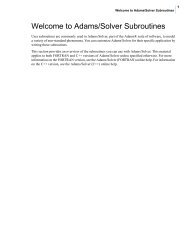You also want an ePaper? Increase the reach of your titles
YUMPU automatically turns print PDFs into web optimized ePapers that Google loves.
2.9 Setting Tool Compensation<br />
Using <strong>Virtual</strong> <strong>Machine</strong> Models with CeRun and Gener<br />
Setting Tool Compensation<br />
On most machines, the CNC provides some form of tool compensation<br />
to adjust for differences in the length (or position) and diameter of the<br />
tool. VM provides a virtual controller that supports both fixture and<br />
tool compensation. The VM controller can be activated from the View toolbar by selecting the<br />
button shown circled in the toolbar above. Select the button a second time to either hide the<br />
controller window or to restore a controller window that has been minimized. This window can<br />
also be controlled by selecting Simulation»Controller from the menu bar. Once the VM Controller<br />
window is active, select the Tool Compensation tab to define or modify tool length and<br />
diameter compensation amounts.<br />
Note: VM will not let you add length and/or diameter compensation offsets if these features are<br />
not available on the machine (as defined in the post-processor or control emulator).<br />
<strong>ICAM</strong> provides “Manufacturing Extractors” for many popular CAM systems, which can automatically<br />
define tool compensation settings from tooling used in the NC program.<br />
Tool compensation data is<br />
automatically saved in the<br />
verification setup (.vsw) file<br />
when the program is completed.<br />
This setup file will be<br />
reused on subsequent runs to<br />
quickly reestablish the tool<br />
compensation settings necessary<br />
for an accurate simulation.<br />
2.9.1 Length Compensation<br />
Length compensation typically adjusts the Z-axis position of the control point, to account for<br />
differences between programmed and actual tool lengths. If the NC program already compensates<br />
for tool lengths in the coordinate data, then length compensation is not necessary in VM. If<br />
the coordinate data does not take into account the gage length of the tool, then length compensation<br />
must be used with VM to correctly check the NC program. Press the Add button and then<br />
enter the length compensation ID to be added. You can select any axis of any ID and type a new<br />
value. You can also select one or more IDs and use the Set and Zero buttons to set or zero offsets<br />
for all selected IDs simultaneously.<br />
2.9.2 Diameter Compensation<br />
Diameter compensation adjusts the trajectory of the tool to compensate for differences between<br />
the programmed and actual tool diameters. Most CAM systems output coordinate data that is<br />
already offset from the part surface by the radius of the tool, making diameter compensation<br />
unnecessary in VM. If the coordinate data represents the contact point of the tool with the<br />
surface instead of the tool center point, then diameter compensation must be used with VM to<br />
correctly check the NC program. Press the Add button, and then enter the diameter compensation<br />
ID to be added. You can select any ID and type a new diameter value. You can also select one or<br />
more IDs and use the Zero button to zero offsets for all selected IDs simultaneously.<br />
<strong>ICAM</strong> Technologies Corporation – Proprietary 29















